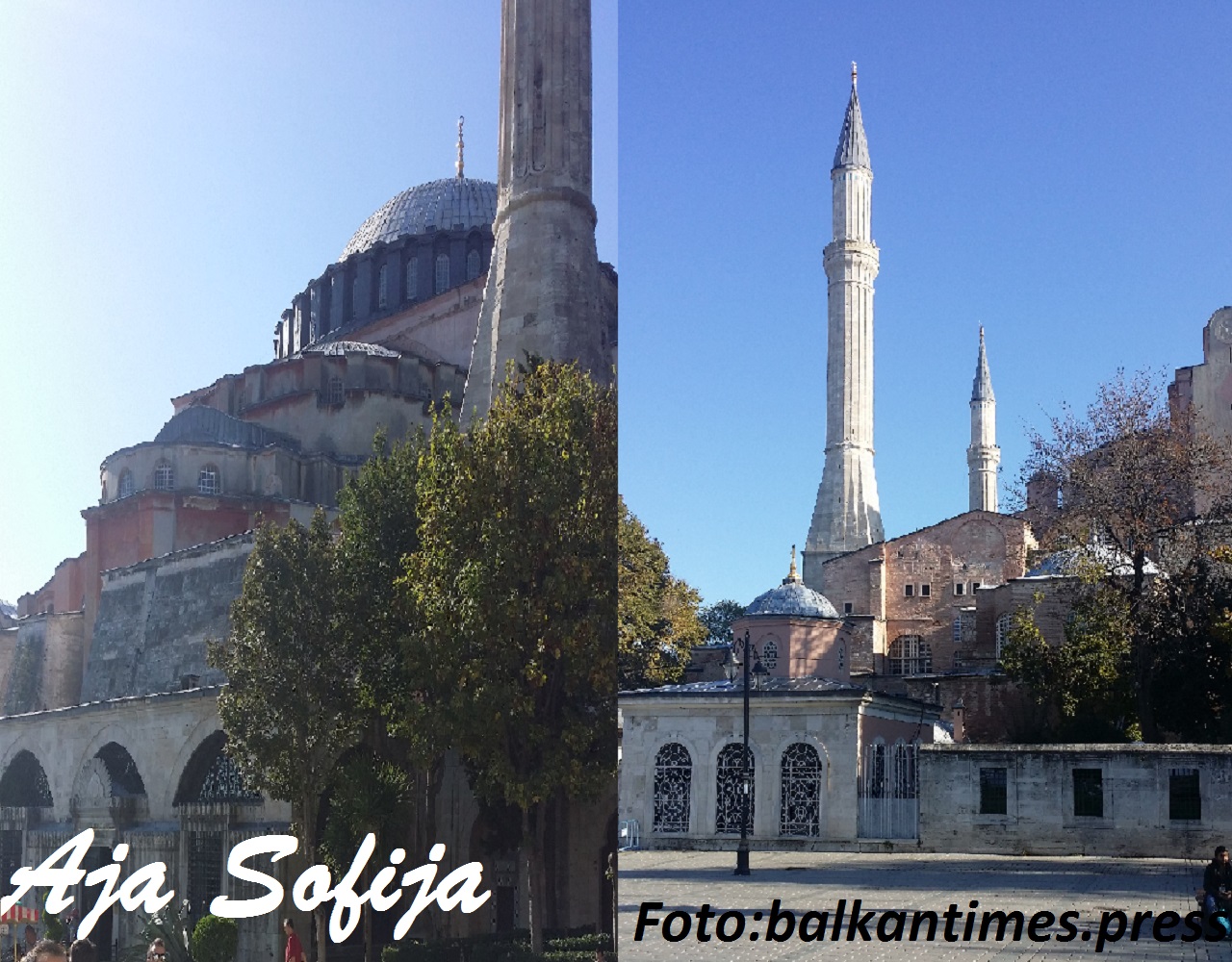Visit Hyige Sofia
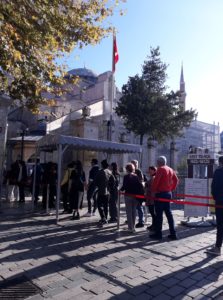
We were standing in front of Ay Sofia, beside us numerous visitors and groups (whose guides were carrying flags) printed towards the entrance. Ozy, our guide was supposed to carry the flag that reads Istanbul. We waited a long time because we had come early and did not know the exact meeting place of the group. When we got to the entrance they brought us back. In general turmoil, I ask the young man at the entrance how to find a guide, explain that we have electronic tickets and show my mobile phone? It turned out that I happened to run into Ozi, our group was together and we headed to the entrance. I used every moment to take as many photos as possible.
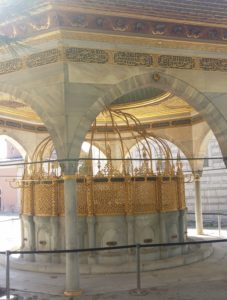
At the entrance to the courtyard in front of us shone a beautiful gilded carpet from the Ottoman period. As we stood in front of Ay Sofia, Ozy began the story of her construction. It was built only after the third attempt, changing its purpose as many times. It was the largest Orthodox church for almost 1000 years, a short time and a Catholic cathedral, then a mosque for 500 years, 100 years ago it was turned into a museum, visited by more than three million tourists annually. The museum now preserves the building and its unique and fascinating history of the East and West, the Byzantine and Ottoman Empire, and Christianity and Islam.

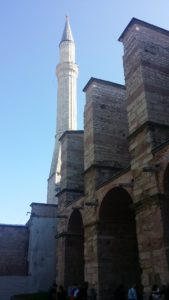

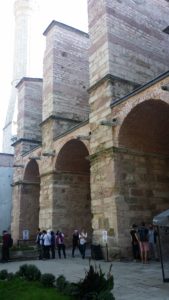
Church building
Hail Sophia began to be built by Constantine the Great; it was much smaller than it is today, but it was destroyed in a fire. It was rebuilt and extended at the end of the 4th century, but was again destroyed to the ground in the rebellion of Nick 532.
The rebellion of Nika caused such unrest and the burning of the city that the Emperor Justinian, in despair, wanted to escape, the escape route was open across the sea. Empress Theodora, who had a great influence, distracted him from this intention by saying, “I better be dead if they will not greet me as the Empress-velvet is the best mortuary cover – those who wear the crown better not be alive if they lose it.” She sent an imperial army to quell the rebellion, killing about 30,000 people. Justinian then consolidated his rule, Hagia Sophia was demolished to the ground. After the rebellion, the Emperor initiated the reconstruction of the city and built the new Hagia Sophia in only 5 years. Ozy said we were just standing in front of that sixth-century Hagia Sophia. One legend says that the material that made Hagia Sophia was made from all four sides of the world and that it was built of pillars and stones of ancient places of worship. Taking part from each place, Justinian wanted to show that he rules the whole world.
The new Hagia Sophia was built for the clergy, the emperor and his court, not as a church where ordinary citizens could pray. According to legend, the first sentence Emperor Justinian uttered in the newly built Hagia Sophia was “Solomon, I have surpassed you.” He was referring to the Jewish emperor who built the famous temple in Jerusalem. For the next 1000 years, Hagia Sophia was the largest church in the world. Ozy said he is not among the top 10 today. The new church had a massive dome on top, large mosaics, stone slabs, marble columns, bronze and marble doors and a large cross atop the dome. Instead of masonry, brick and marble from Egypt, Rome, Aubei, Africa were used. In addition to marble, silver and gold plates and ivory were also brought in to build the altar.
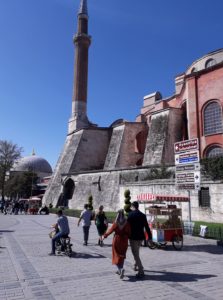
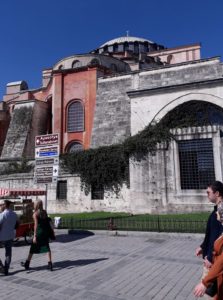

Interior
First we entered the long corridor above which gilded vaults curved, the guide showed us the mosaics that were restored after the church became a museum. There were several doors in the hall of the church, one door in the middle stood out for its size. It was the main door, used only by emperors. The ritual of the Emperor entering Hagia Sophia looked like this: he would come in carrying a large candle, he would worship three times before this door while the church choir sang. The 9th century story states that massive Noah’s bar boards were built into the door. The door was known as the Silver Gate and the Beautiful Gate.

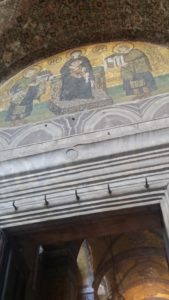


Mosaics
Mosaics are made of glass of gold and silver. The Byzantine ideal of beauty was promoted: tall, graceful figures, oval heads with piercing eyes, bent eyebrows, and lavish attire. The figures on these mosaics were static, ceremonial, with huge almond eyes, and the background was gold (the sky is always gold in early Christianity). Above the door in the hallway was the first mosaic, on which Emperor Leon VI was kneeling. On the mosaic, Jesus is seated on a throne, and on his right and left are Gabriel and the Virgin Mary. Leon VI is shown begging to have his fourth marriage. The Emperor had already married three times, but had not received a son. The emperor must have had a male descendant at that time. Leon had already been married without permission to a woman who had remained in another condition and had given birth to a son, he was seeking permission for another marriage. He was allowed to enter only the hall of the church, in which we were at that moment, to walk to the end of the aisle, where he could, in ‘outrage’, watch and listen to the liturgy. Over time the problem was resolved, after much repentance Leon was still allowed to re-enter Hagia Sophia and receive the sacrament.
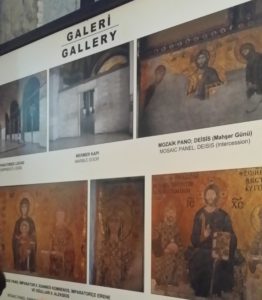
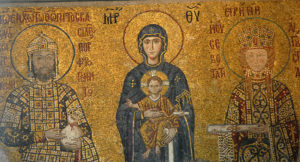
Ozy led us to the front door to see a mosaic dating from the 9th century. This mosaic was opened with a religious ceremony, since the first mosaic of the period was post iconoclasm. The mosaic depicts the Byzantine emperor Justinian and the Roman emperor Constantine. On the right, Emperor Constantine represents Constantinople, and on the left Justinian represents Hagia Sophia to Jesus in the middle, carried by the Virgin Mary.
In the gallery of Hagia Sophia there was also a mosaic of Constantine IX Monomah and his wife Zoya. The mosaic shows that the face of Zoya’s third husband was cut out and added to a pre-existing mosaic that was made at the time of her first marriage to Roman III Argir. It is one of the first ‘photomontages known’ in history.
Earthquakes and dome
We entered through the imperial gates after an hour of history related to the Byzantine period. We found ourselves under a dome with a beautifully painted vault of elliptical shape. The dome, 30.8m x 31.88 m in diameter, was shaped like an omphalion, the central and main parts of which extended from the entrance to the aisle near the altar in front of where the emperors were crowned. There was a mixture of scents and incense and musk all over the room. The light of the lowered chandeliers mingled with the living room, which entered through a large number of windows in bundles, which made Ayia Sofia even more mystical. Every corner, pillar, even marble floor had its own story.
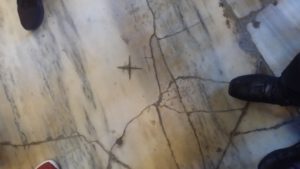
Hagia Sophia was seriously damaged less than 20 years after it was completed by a series of earthquakes that crashed the main dome. The dome rebuilt, remodeled and erected some 20 feet. These improvements were quickly completed and made by 562 AD. Ozy explained and practically showed us that the center of the dome does not lie in the middle of the metal cross on the floor, which is placed just below the top of the dome. He put a cellphone with a camera on the cross, the video showed that the top of the dome was not in the center, when he placed the phone about ten centimeters to the right, the center of the dome was the focus of the camera. Ozy noted that the dome was not to blame as the tower in Pisa, but the earthquake still caused a slight inclination of the dome.
Poles
In Hagia Sophia, there are many pillars that are set up to hold the dome and additionally decorate the interior. The most important 107 pillars of Hagia Sophia are on the ground floor. Historical sources agree that they were brought from the Temple of Heliopolis and the monuments in Rome. There are also pillars made specifically for Hagia Sophia in Thessaly and Marmara Island. The columns and arches that connect them are important elements that enrich the architectural beauty of Hagia Sophia. We can even say that there are masterpieces of 6th century carving art here. The tops of the columns are precisely carved with a lace design. The monograms of Justinian and his wife Theodore can also be seen on them. The carvings on the arches connecting the columns show the same style of work. The lower portions of the arches are decorated with mosaics.
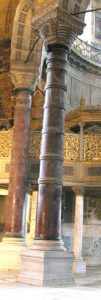
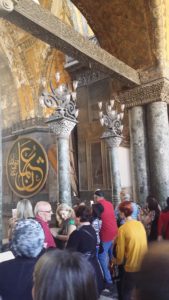
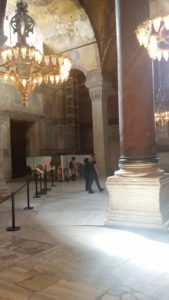

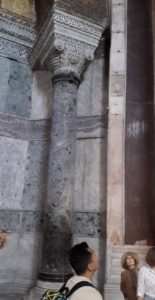
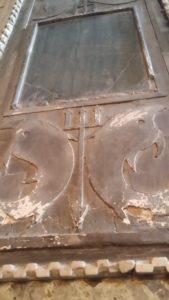
Pillars were also brought from the long-abandoned and destroyed Temple of Artemis in Ephesus. On one pillar stands a mosaic of dolphins and tridents, which is reminiscent of Poseidon in Greek mythology.
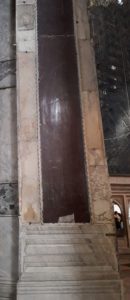
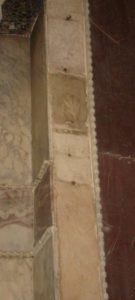
Near the beginning of one pillar was a fist-sized spot where the paint was worn out. Ozy put his hand in that place, after which he said let’s look at the top. When we did, we saw a fist shadow near the top. There are also several legends attached to this pillar, one of them says that it is the hand of a Byzantine princess who fell in love with the Turkish sultan.

Those who have visited Hagia Sophia surely know of the ‘Pillar of Tears’. There is a belief that the wish of the one who puts his finger in the hole on the pole will be fulfilled and if he manages to turn his hand 360 degrees. Byzantine sources mention that a saint healer transferred his healing power to this pillar. So the pole, which is always a little damp, and is also called the “sweaty pole”, has become a legend. According to other beliefs, when the Hagia Sophia’s dome collapsed in an earthquake, 300 priests went to Mecca and made plaster of Zem-Zem water and land there, which they put under this pillar. It is believed that this is why the stem is always damp.
There are many places in Hagia Sophia where there are inscriptions in several languages. The Vikings have also left their signature, and there is a tombstone of Henricus Dondola the Crusader, who wanted to be buried there.

Walls and floor of Hagia Sophia
The walls of the main room are covered with marble all the way to the upper reaches of the gallery. The side winding walls and the inside are marble from floor to top. Marbles of all colors from different parts of the empire have been specially selected for Ayia Sofia. For a circle on the floor called Omphalion (the place where the emperors were crowned) and a place that was acoustic, a red stone was brought from Egypt, a green stone from Thessaly, a black stone from Bosphorus, a yellow stone from Syria, a white stone from Cappadocia and a golden stone from Libya.
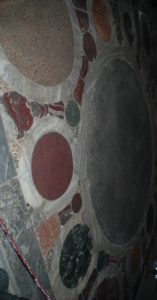
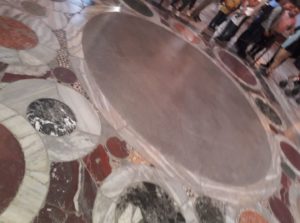
The floor of the main part of the church is covered with gray and white marble. This type of flooring is foreign to the architectural style of Hagia Sophia, so it’s probably taken from some other monuments. The huge window frames were originally made of marble. A few have been preserved, but most have been replaced. In Justinian’s time, all windows were glazed with large square frames of opaque light bluish or light green glass. Glass has been used in Rome since the first century, remains were also found in the excavations of Pompeii, where it was discovered in original wooden frames. It is known from Justinian’s decrees that there was glass production in Constantinople, but outside the city walls for safety reasons. Later, translucent glass was used and continued to be used in Byzantine buildings until 1453.
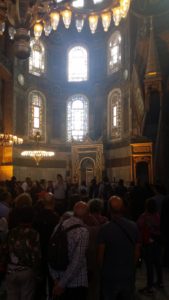
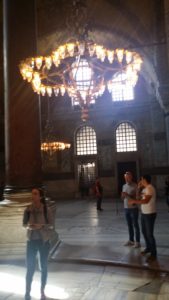


The dome was recently restored with a six-winged Blue Angel. According to the Old Testament, he was tasked with leading people to paradise. In Byzantium, they believed that Serafin protected the city from numerous sieges, because for many thousands of years many attempts to conquer the city were thwarted.

There is a cat in Hagia Sophia
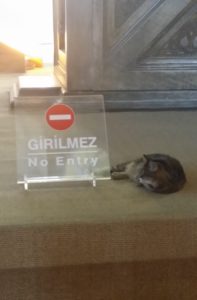
In addition to Mimber on the marble floor, a cat swears on the marble floor, Ozy said she is 16 years old, and that is a lot x7 years more for a cat. She has been living in the current Hagia Sophia Museum for so many years, she has come to terms with the interior and visitors, and she acts as if they are gone. It is an ‘ordinary’ cat, which has become very popular because it resides in Ayia Sofia. It even has its own Instagram profile:
https://www.instagram.com/hagiasophiacat/
On which there are more than 16 thousand escorts. So modern myths are starting to emerge around Aya Sofia: Aya Sofia still follows trends, building it for centuries, adapting to new rulers, times now and new trends, always attracts attention, much is written about it on the internet and on social networks.
https://www.instagram.com/p/B7kyDf7Avyr/
Aya Sofia’s purpose
Hagia Sophia witnessed two empires, so far there have been several alterations and serious reconstructions during which the church was not opened. This was due to frequent earthquakes, several of which severely damaged the dome. During one of the reconstructions the dome was erected for another 6 meters and the church was closed for ten years. It was not until the Paleologian dynasty that the church was reconstructed in detail and the retaining walls and facade were made. Unfortunately, in the crusades, in one of the robberies of 1204, the church was looted. Gold, artwork, imperial portal, silver crosses were taken away. During the Latin Empire, from 1204 to 1261, Hagia Sophia became a Roman Catholic cathedral.
 After the conquest of Istanbul, Ayia Sofia became the main mosque in the Ottoman Empire. It was named “Cami-i Kebir”, which means “grand mosque”. Aya Sophia had much greater meanings in Turkish-Islamic culture than any other mosque. It occupies a central place in the civil service of the Ottomans. It is the first mosque where the sultans and other statesmen met with the people during the mosque and bajram prayer.
After the conquest of Istanbul, Ayia Sofia became the main mosque in the Ottoman Empire. It was named “Cami-i Kebir”, which means “grand mosque”. Aya Sophia had much greater meanings in Turkish-Islamic culture than any other mosque. It occupies a central place in the civil service of the Ottomans. It is the first mosque where the sultans and other statesmen met with the people during the mosque and bajram prayer.




During the time of Ayia Sophia’s church, it served only the emperors and the clergy, after the conquest of Isatmbula the Byzantine emperors became the past. The Ottomans needed a big place of worship for everyone to use, which was Hagia Sophia. It is here that, according to tradition, Sultan Mehmed II Fatih fell for the first time in his seat. The first juma after the conquest of Istanbul was worshiped in Ayia Sofia. Hagia Sophia also underwent numerous changes during the transformation from church to mosque: she received 4 minarets, which are the work of Mimar Sinan, and were added madrasa, mimber and mihrab.
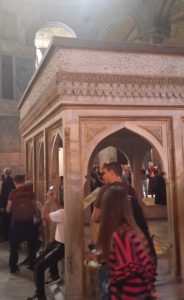
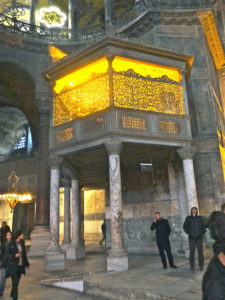


In the 12th century, panels were placed on the interior walls bearing calligraphic inscriptions of the divine name of Allah, followed by the names of Muhammad a.s, Khalifa Abu Bekir, Omer, Osman, Alia and his sons Hassan and Hussein. These inscriptions represent the largest calligraphic inscriptions in the Islamic world. The muezzine room was built, as well as several terraces from which during the mosque the believers could listen to the hutba (lectures). The place where the emperors were crowned was acoustic for the reason that it was in one of the focuses of the elliptical form of the building and was used to teach ezans. When Hagia Sophia became a mosque, the emperor’s door was reserved for the Sultan and was covered with silk curtains and inscribed with verses from the Qur’an.
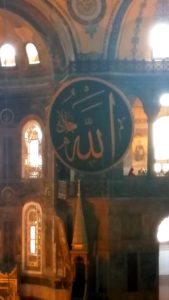


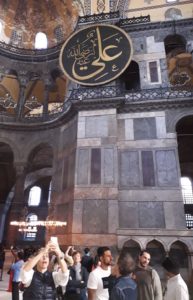
Hagia Sophia – the mosque that made the Grand Bazaar online
When Sultan Mehmet II ordered the conversion of the church into a mosque, Hagia Sophia became a symbol of the conquest of Istanbul. The Sultans worked various additions and restorations on Hagia Sophia. The interior and main structure of Hagia Sophia have not been altered. In order to raise funds for the reconstruction of Hagia Sophia, in the early 15th century, Sultan Mehmed II made the Grand Bazaar or Kapali čaršija, which is still the best place for trade in Istanbul today. This huge covered space is essentially the world’s first mall. Two Marble Amphorae for Wash Before Prayer Sultan Murat III ordered that they be brought in the mid-16th century from ancient Pergamum, candelabra from Buda, the works of art were made by the best artists. During the Ottoman period, each amphora was with a lid and a tap and was used for religious washing before prayer.

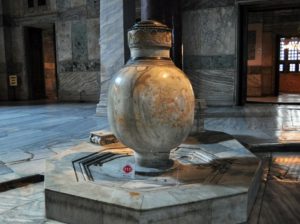
During the reign of Sultan Mahmud I (1739) a library was built in a special building decorated with beautiful tiles, a fountain was arranged in the courtyard, an observatory, a sultan’s residence, a school were made. When Hagia Sophia was used as a mosque, the ornaments and mosaics with human figures were covered with plaster, which helped to keep the mosaics preserved to this day. The most extensive restoration was done in 1847 during the time of Abdulmedzhit I, who hired Italian architect Gaspar Fosati to strengthen the dome with iron reinforcement, while preserving the mosaics from moisture. Hatat caller Izet Effendi decorated the dome with verses from the Qur’an. Until the end of the 19th century, the mosque was restored and preserved, beautified and protected.

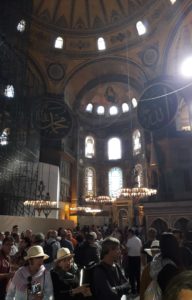
How did Hagia Sophia turn from Jerusalem in the direction of the Kabeah?
Since the Orthodox churches were facing east, the mihrab of the mosque had to be facing Kaba, southeast. Mihrab is located below the fresco where the main altar was, which meant that Hagia Sophia was facing Mecca. There are many legends that the kibble that Muslims turned to with Aya Sofia’s earlier orientation came about. According to legend, Sultan Mehmet Fatih, as he was worshiping the first Juma in Ayia Sofia, saw Kabu in front of him, and that Hazrat Hydr, placing his finger in the “Pillar of Tears”, turned the whole building in the direction of Kaba. Scientists explain this phenomenon with tectonic movements, of which there have been many in this area. Which meant that Hagia Sophia ‘turned’ on herself to Mecca. This turn of the symbolism is a turning point in the fate of Hagia Sophia, from Christianity to Islam.
Most important for Muslims was the hadith of Prophet Muhammad, which is inscribed on a pillar in front of the exit door on a panel translated from Arabic into Turkish. The plaque reads: “Surely Constantinople will be conquered, so is the military commander this man wonderful and is it wonderful that the army will accomplish this.” (Sahih – Ahmed 4/235 and El-hakim 4/442).

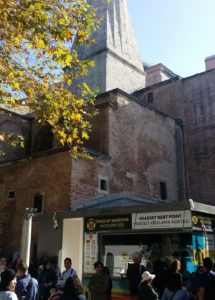
Hagia Sophia Museum
Thus, in 1935, not nearly 500 years after the fall of Constantinople, then Turkish President Mustafa Kemal Ataturk decided that Aja Sophia should be secularized and turned into a museum, today protected by UNESCO. All the wealth was spent on the works. Kemal Pasha Ataturk, founder of the modern Turkish Republic, declared Aja Sophia a national monument and turned it into a museum – Ayasofya Müzesi.
For the end

We climbed the spiral slope-ramp to the second floor of Hagia Sophia, already weary we were in an ancient space paved with uneven and smooth medieval cobblestone. There were no stairs, because the emperors who spent their time in that part of the church were carried on stretchers, sometimes riding horses on this ramp.

From the second floor, the view covered the entire room below. In one part there was a green marble floor with green pillars on either side. This place was reserved for the imperial throne, from which the emperors had a direct view of the apse. They watched (unnoticed by the others) what was going on in the church. In the end we walked down a long corridor to an exit we could hardly find, because the museum was a maze.
Ozy mentioned the bronze door, which, according to legend, when Sultan Murat II opened, it could no longer be closed. He also mentioned some other doors that led to secret rooms, which no one could open again (there seemed to be many secret rooms), and all the legends were tied, and we were so tired and full of impressions that we went out to the ordinary door. an arrow indicating the exit.
Napomena o autorskim pravima: Dozvoljeno preuzimanje sadržaja isključivo uz navođenje linka prema stranici našeg portala sa koje je sadržaj preuzet. Stavovi izraženi u ovom tekstu autorovi su i ne odražavaju nužno uredničku politiku The Balkantimes Press.
Copyright Notice: It is allowed to download the content only by providing a link to the page of our portal from which the content was downloaded. The views expressed in this text are those of the authors and do not necessarily reflect the editorial policies of The Balkantimes Press.

